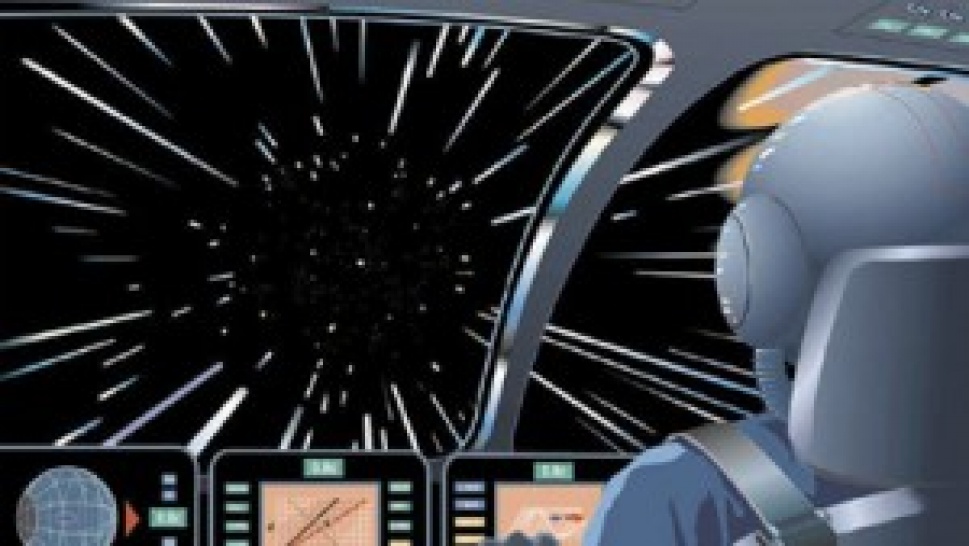Early scientists, unable to perceive light’s motion, thought it must travel instantaneously. Over time, however, measurements of the motion of these wave-like particles became more and more precise. Thanks to the work of Albert Einstein and others, we now understand light speed to be a theoretical limit: light speed — a constant called "c" — is thought to be not acheivable by anything with mass, for reasons explained below. That doesn’t stop sci-fi writers, and even some very serious scientists, from imagining alternative theories that would allow for some awfully fast trips around the universe.
The first known discourse on the speed of light comes from the ancient Greek philosopher Aristotle, who penned his disagreement with another Greek scientist, Empedocles. Empedocles argued that because light moved, it must take time to travel. Aristotle, believing light to travel instantaneously, disagreed.
In 1667, the Italian astronomer Galileo stood two people on a hill at a distance of less than a mile, each holding a shielded lantern. One uncovered his lantern; when the second saw the flash, he uncovered his, as well. By observing how long it took for the light to be seen by the first lantern-holder (and factoring out reaction times), he thought he could calculate the speed of light. Unfortunately, Galileo's distances were too small to see a difference, so he could only determine that light traveled at least ten times faster than sound.
In the 1670s, Danish astronomer Ole Römer used eclipses of Jupiter's moon, Io, as a chronometer for the speed of light. Over the course of several months, as Io passed behind the giant gas planet, Römer found that the eclipses came later than calculations anticipated, although over the course of several months, they drew closer to the predictions. He determined that light took time to travel from Io to Earth. The eclipses lagged the most when Jupiter and Earth were farthest apart, and were on schedule as they were closer. He concluded that light took ten to eleven minutes to travel from the sun to the Earth, an overestimate since it in fact takes 8 minutes and 19 seconds. But at last scientists had a number to work with – his calculation presented a speed of 125,000 miles per second (200,000 km/s).
In 1728, English physicist James Bradley based his calculations on the change in the apparent position of the stars due Earth's travels around the sun. He put the speed of light at 185,000 miles per second (301,000 km/s), accuate to within about 1 percent.
Two attempts in the mid-1800s brought the problem back to Earth. French physicist Hippolyte Fizeau set a beam of light on a rapidly-rotating toothed wheel, with a mirror set up 5 miles away to reflect it back to its source. Varying the speed of the wheel allowed Fizeau to calculate how long it took for the light to travel out of the hole, to the adjacent mirror, and back through the gap. Another French physicist, Leon Foucault, used a rotating mirror rather than a wheel. The two independent methods each came within about 1,000 miles per second of the speed of light measured today.
Prussian-born Albert Michelson, who grew up in the United States, attempted to replicate Focault's method in 1879, but used a longer distance, as well as extremely high-quality mirrors and lenses. His result of 186,355 miles per second (299,910 km/s) was accepted as the most accurate measurement of the speed of light for forty years, when Michelson remeasured it.

Einstein and special relativity
In 1905, Albert Einstein wrote his first paper on special relativity. In it, he established that light travels at the same speed no matter how fast the observer moves. Even using the most precise measurements possible, the speed of light remains the same for an observer standing still on the face of the Earth as it does for one traveling in a supersonic jet above its surface. Similarly, even though the Earth is orbiting the sun, which is itself moving around the Milky Way, which is a galaxy traveling through space, the measured speed of light coming from our sun would be the same whether one stood inside or outside of the galaxy to calculate it. Similarly, Einstein calculated that the speed of light doesn't vary with time or place.
What’s a light-year?
The speed of light can cause the universe to seem to host a time machine. The distance light travels in the course of a year is called a light-year. A light-year is a measure of both time and distance. It’s not as hard to understand as it seems. Think of it this way: Light travels from the moon to our eyes in about 1 second, which means the moon is about 1 light-second away. Sunlight take about 8 minutes to reach our eyes, so the sun is about 8 light-minutes away. Light from the nearest star system, Alpha Centauri, is requires roughly 4.3 years to get here, so that star system is said to be 4.3 light-years away.
Stars and other objects beyond our solar system lay anywhere from a few light-years to a few billion light-years away. Thus, when astronomers study objects that lays a light-year away or more, they are seeing it as existed at the time that light left it, not as it would appear if they stood near its surface today. In this sense, everything we see in the distant universe is, literally, history.
This principle allows astronomers to see how the universe as it looked after the Big Bang, which took place about 13.7 billion years ago. Examining objects that are, say, 10 billion light-years away, we see them as they looked 10 billion years ago, relatively soon after the beginning of the universe, rather than how they appear today.
Is the speed of light really constant?
Light travels in waves, and, like sound, can be slowed depending on what it is traveling through. Nothing can outpace light in a vacuum. However, if a region contains any matter, even dust, light can bend when it comes in contact with the particles, which results in a decrease in speed.
Light traveling through Earth's atmosphere moves almost as fast as light in a vacuum, while light passing through a diamond is slowed to less than half that speed. Still, it travels through the gem at over 277 million miles per hour (almost 124,000 km/s) – not a speed to scoff at.
Can we travel faster than light?
Science fiction loves to speculate about this, because “warp speed,” as faster-than-light travel is popularly known, would allow us to travel between stars in time frames otherwise impossibly long. And while it has not be proven to be imposssible, the practicality of traveling faster than light renders the idea pretty farfetched.
According to Einstein's general theory of relativity, as an object moves faster, its mass increases, while its length contracts. At the speed of light, such an object has an infinite mass, while its length is 0 – an impossibility. Thus, no object can reach the speed of light the theory goes.
That doesn’t stop theorists from proposing creative and competing theories. The idea of warp speed is not impossible, some say, and perhaps in future generations people will hop between stars the way we travel between cities nowadays. One proposal would involve a spaceship that could fold a space-time bubble around itself in order to exceed the speed of light. Sounds great, in theory.




Share the News